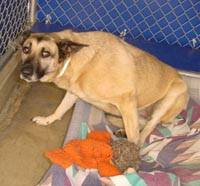If
your dog is barking excessively
and you want to stop it...
DON'T
hit or yell at the dog; dogs
don't understand this type of
message.
DON'T
pet and talk soothingly
to the dog. Dogs may think
you are praising the barking.
DON'T
ignore the barking.
See if you can't remove eye contact
with other dogs.
DO
get the
dog's attention by giving Instructions
and treats.
DO take the dog
outside.
Interrupt the barking, then give
quick
praise and attention when the
dog is NOT barking.
|
Use
the suggestions below to
stop the barking; then give
praise and attention when
the dog is being
quiet. |
DO:
(Try any or all of these suggestions...)
-
Try to determine if the dog
is barking at a specific target
- person, dog, cat, etc. If
so, try to move the dog to
where it cannot see the
object of the barking.
-
If it is a little dog, pick
it up and turn its head away
from the object of the
barking. It is okay to gently hold the
mouth closed. The pet can
breathe through its nose.
Praise ANY quiet.
-
Give the receptionist your
name, and consider going for
a short walk. Change the stimulus
and environment for your dog.
Also, walking is a stress
reliever for dogs.
-
Some
people carry a water mister,
and squirt the dog when it
barks to divert attention
just long enough to stop the
barking, then immediately
begin stroking and praising
the quiet behavior.|
-
If responsive to a collar
correction, give a moderate
snap on the leash and say,
"Quiet".
Immediately praise any
silence. Give the dog
a new Instruction and praise.
-
Most importantly, when the dog
does stop barking, give praise
and positive attention. If
your dog likes food, bring
treats with you to the visit
for rewards.
 If
this is a recurring problem,
talk to the veterinarian about
a mild sedative for next visit.
It will be much less stressful
for the dog. The vet may be
able to give a more thorough
exam, plus you can be more relaxed.
Do not use a tranquilizer if
the dog is showing any signs
of illness or aggression. Use only for
vaccine visits or routine physical
exams with a healthy pet.
If
this is a recurring problem,
talk to the veterinarian about
a mild sedative for next visit.
It will be much less stressful
for the dog. The vet may be
able to give a more thorough
exam, plus you can be more relaxed.
Do not use a tranquilizer if
the dog is showing any signs
of illness or aggression. Use only for
vaccine visits or routine physical
exams with a healthy pet.